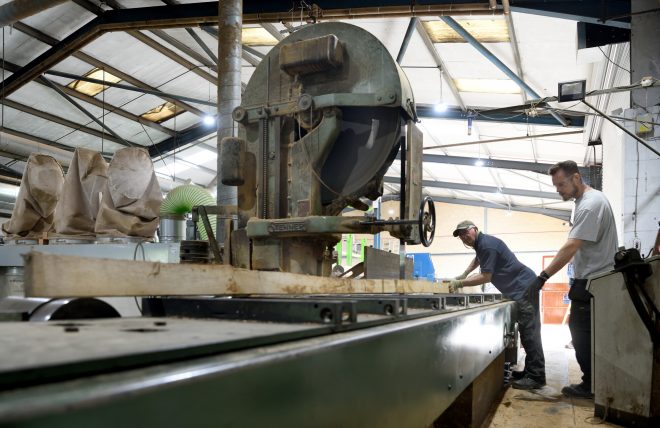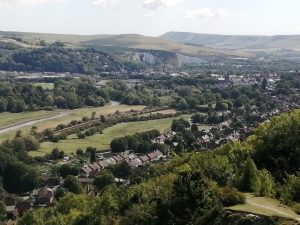SMEs and planning in a National Park – what you need to know
December 19, 2023

Business planning is more important than ever for an SME in 2024.
Knowing your strategy to support the business and having a firm grip on the numbers is key for success and growth, especially when margins are tightening with the increasing cost of energy and supplies.
But there will be a stage in the lifetime of many a South Downs business when you may have to dabble in a different kind of planning – that of submitting a detailed application to the National Park Authority in order to gain planning permission.
It could be your business is needing extra space, diversifying, implementing cost-saving renewable energy projects or you could be one of the numerous small and medium-sized property developers that are such a crucial part of the local housebuilding industry.
Applying for planning permission in a National Park comes with its own opportunities and challenges. This is a protected landscape, designated for the nation for its natural beauty, wildlife and cultural heritage. So, new development must take these factors into account. The bar is set high for any proposal’s design and sustainability credentials. The National Park is also about creating opportunities for people to enjoy this amazing space – a key opportunity, therefore, for land and visitor-based or tourism businesses.
Located in the busiest part of England, placemaking is a job the National Park Authority approaches with care, recognising its responsibility. Did you know the National Park Authority deals with over 5,000 planning cases a year and is in the top 30 busiest Planning Authorities in the UK?
With all this in mind, what are the key aspects businesses should consider if seeking planning permission from the National Park Authority? And is there a pearl of wisdom that will ensure a green light to your plans?
 “The first port of call for any SME looking to submit a planning application is to engage with us early,” says Mike Hughes, Interim Director of Planning.
“The first port of call for any SME looking to submit a planning application is to engage with us early,” says Mike Hughes, Interim Director of Planning.
“Take pre-application advice and provide as much information as possible, being open and transparent about aspirations, as well as your needs.
“Tell us the bigger picture of what you are doing, especially if you are doing anything in relation to climate action, access for all or any nature recovery work. This is a genuine consideration for us and we will work with you closely if you are able to increase your actions in this area.
“We deal with applications large and small, but if it’s a big project we would always recommend you invest in a planning agent. They will have the skills and know-how to navigate the planning system and ensure you have the best possible chance of a successful outcome. It may be costly, but it will save time and most likely cost in the end.
“If you make an application, do look at our One App validation list, in terms of what is required. Bear in mind many of the requirements are set nationally.”
Mike explains that being aware of the policies that apply to your proposal is also important, not just any single policy but the Local Plan as a whole.
In the National Park, the “gold standard” is the South Downs Local Plan – a detailed summary of all the key policies around where development can take place, design opportunities, the protection of habitats and ecosystem services such as the South Downs Aquifer, renewable energy, and lots more.
There are a plethora of “Supplementary Planning Documents” and “Technical Advice Notes” – basically more detailed guides for applicants that help shape your proposals – around all kinds of aspects, such as parking, building design, dark sky protection and camping and glamping, to name but a few. It’s also good to know, for instance, if your proposal is located in a conservation area and what that means for design. You can see now the benefit of hiring a planning agent for all but the most basic of schemes but do feel free to talk to us first!
The South Downs Local Plan also places an emphasis on supporting the rural economy and fostering thriving local communities, so the door is always open to SMEs looking to help meet these goals.
“Don’t be afraid to sell your scheme,” adds Mike.
“This is a National Park but it’s not a museum. We really do welcome an open conversation about proposals that innovate and look to the future. We want to work with you and try and make something happen, that is the buzz of planning. If, however, a scheme is clearly unacceptable, we will try and tell you early.”

Asked about whether there’s a winning formula to obtaining planning permission in the National Park, Mike says the biggest consideration is landscape and design in its widest sense.
“The fundamental question we will ask is have you considered the landscape in the development of your plans and how have you adapted plans to reflect this?” explains Mike.
“The Authority will always be considering whether any scheme has been landscape led by the applicant or their agents. Respecting the context or the character of the area, for example the building materials reflecting the geology and availability of the locality, or dark night sky considerations and how this has informed the design of the building and surrounding landscaping will always be pivotal in our thinking. The Local Plan reflects this.
“We encourage applicants to briefly tell the story of how you’ve arrived at your final design and layout.
“Understanding context and responding to it in a positive way gives the best chance for a scheme to succeed, in my experience. Who knows, you could win a South Downs Design Award which we know from previous winners has some value and adds to their brand.”
People and communities are at the heart of the National Park, so be sure to connect and liaise with local residents, other businesses and community groups.
“As a basic point we always encourage applicants to undertake some community engagement, irrespective of the size of any particular scheme prior to submitting an application,” says Mike.
“This may vary depending on the context, but we would suggest at the least that applicants consult adjoining neighbours. It may be that some suggestions by local residents can be incorporated in the scheme and they feel that their concerns have been heard.”
For more information on planning applications, including whether planning permission is needed for a particular proposal, head to this webpage
If you are making an application visit www.southdowns.gov.uk/planning-applications/apply/
